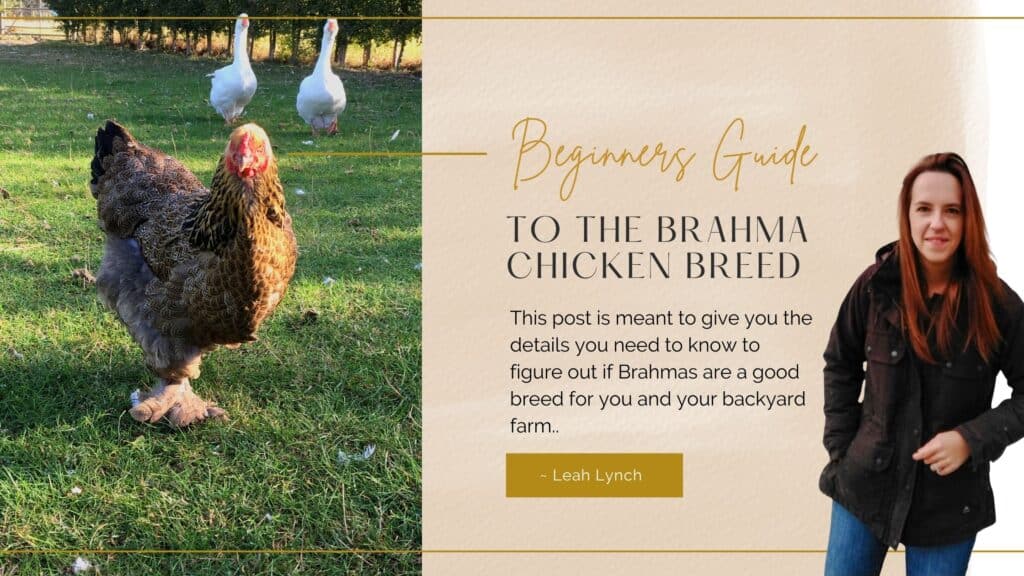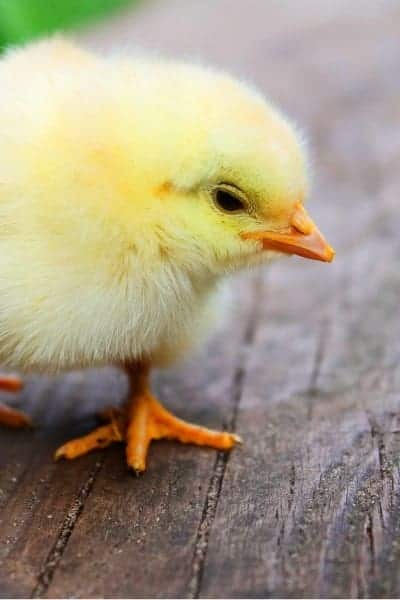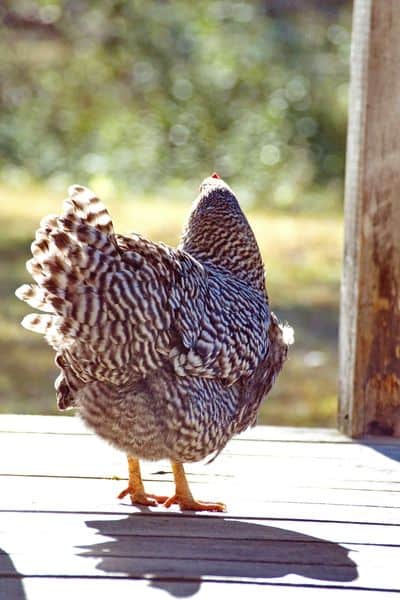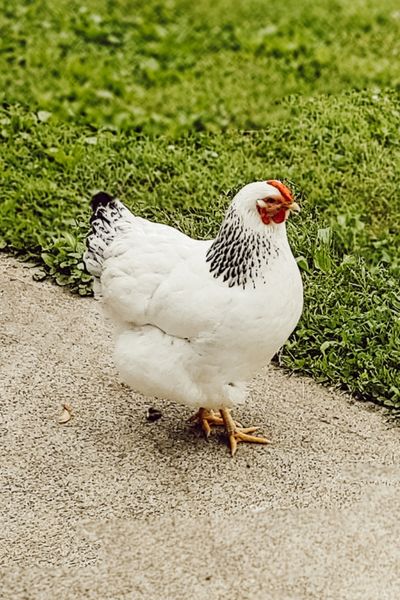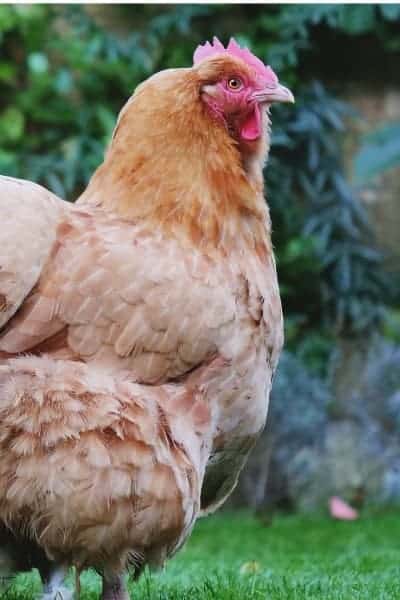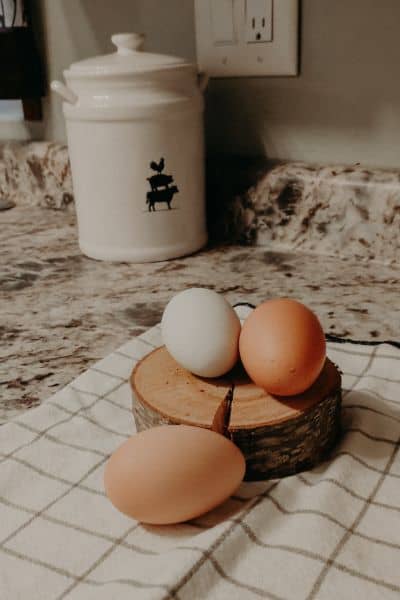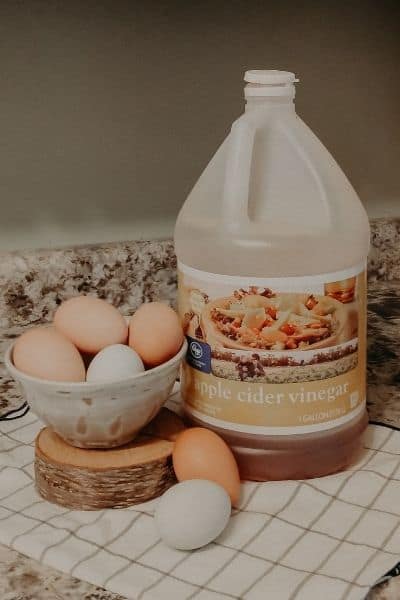Beginners Guide To The Brahma Chicken Breed, Size, Eggs, And More
If you are looking into getting the Brahma chicken breed they are a great large bird to add to your flock. I have never run into a nasty large brahma chicken which is great if you are new to raising chickens altogether.
It surprises me that you don’t see them around more often. Let’s get into the details of this breed of chicken and you can decide for yourself if they are right for you.
Quick Brahma Chicken Overview
These beauties are known as gentle giants in the chicken world, and I totally agree.
Brahma chickens are known for their massive body size. They are one of the largest chicken breeds out there, giving them a commanding presence.
In terms of appearance, Brahmas come in a few different colors, including light and buff. Their feathers are remarkable, with soft white feathers and striking black striping or penciling. These patterns give them a unique and eye-catching look that makes them stand out from your average chicken.
But it’s not just their fancy feathers that make Brahmas special. These birds have a distinctive feather type called “saddle feathers” that hang down from their backside, giving them a distinguished and regal appearance. Talk about style!
When it comes to temperament, Brahmas are known for being calm and docile birds. They have a gentle nature that makes them great for chicken keepers of all experience levels. Plus, their feathered feet and pea comb add to their appeal – who can resist those fluffy feet?
Free Farm Goal Planner!!!
➡️Get my proven system for choosing your farm goals so you don’t get burnt out.
Colors of Brahma Chickens
Brahma chickens have a few different color varieties. From the elegant light Brahmas with their soft, white feathers and black striping to the stunning buff Brahmas with their golden-colored plumage, there’s a color to suit every taste.
Light Brahma – Most Common Color
Visually, the Light Brahma is a showstopper. They have a regal presence with their tall stature and wide, fluffed-up bodies.
And let’s talk feathers! Their plumage is an enchanting mix of white with black striping, giving them an air of elegance.
But their fabulous appearance is just the beginning. Light Brahmas are known for their gentle temperament, making them the perfect addition to any backyard flock. They are calm and docile, always happy to strut their stuff without a fuss. Plus, their feathered feet add an extra touch of uniqueness.
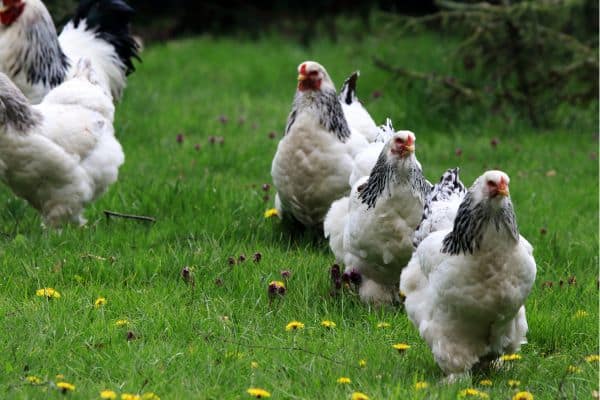
Buff Brahma
Alright, let’s talk about Buff Brahma chickens! They are very similar to the light brahma except instead of white feathers they have a golden color that can lean a little bit red. They still have the black markings around their neck, tail, and feet.
Dark Brahma – Harder To Find
Alright, let’s shine a spotlight on the Dark Brahma chicken breed. These beauties definitely have a more dynamic look in the Brahma world.
But what really sets the Dark Brahmas apart from the other Brahma colors is their unique feather color patterns. They are a gorgeous black and white striping almost like a lacing, creating a truly dramatic and eye-catching effect.
Egg Production and Quality
This breed consistently produces large, light-brown eggs.
On average, you can expect a Brahma hen to lay about 3-4 eggs per week. Of 180-240 eggs per year.
They also on the whole lay pretty large eggs. I have seen some Brahmas lay eggs that are almost equal to 2 standard-size chicken eggs.
Like any chicken seasonality and age slows them down from laying.
Now, there are a few factors that can affect the egg-laying behavior of Brahma chickens.
Age plays a big role here. Young hens, around 6-8 months old, are usually raring to go and will lay eggs more frequently. But as they get older, their productivity might drop a bit.
Seasonality also plays a part. Brahmas, being the chill birds they are, tend to lay fewer eggs during the colder months like any other breed. However, they do tolerate the cold better than a lot of breeds because of their size and amount of feathers.
Don’t Know Where To Start With Your Backyard Farm?
Its time to start a backyard farm that fits YOUR dream lifestyle, Backyard Farm Foundation is the answer to setting a clear plan and achievable goals for starting your dream backyard farm or homestead.
ONLY $9!!!!

Appearance and Body Size
Let’s talk about the appearance and impressive body size of Brahma chickens. These gentle giants are known for their commanding presence and regal demeanor. With their beautiful pea comb and feathered feet, Brahmas are truly one of a kind. They were brought to the United States in the mid 1800s.
Physical Traits
When it comes to size, Brahma’s are one of the largest breeds out there with their massive bodies and wide stances.
And let’s not forget about their feathered feet, which add an extra level of charm to these birds.
When it comes to comb types, Brahma chickens have a distinctive pea comb. This comb sits low on their heads and adds to their regal appearance. This helps them tolerate the cold even better with the smaller comb and avoid frostbite.
They are known for their gentle and calm disposition, making them great backyard pets. With their hardy nature, they can thrive in a variety of climates, from cooler to southern climates. However, because of their size, the tend to do best in cool climates and need lots of shade and water to help stay cool in the heat.
And when it comes to egg production, Brahma hens are decent egg layers compared to other large chicken breeds.
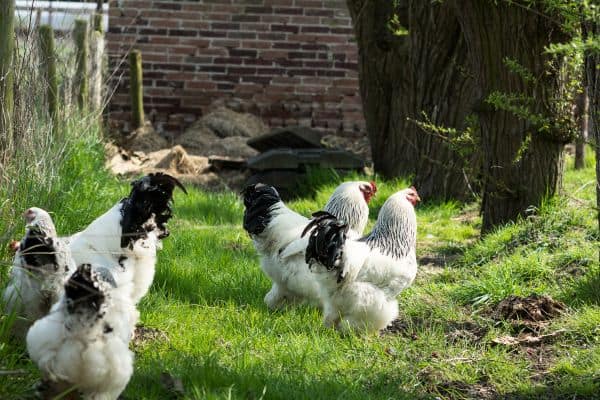
How big are Brahma chickens?
Male and female Brahmas have slightly different sizes. The roosters, or the boys of the bunch, tend to be on the larger side, standing taller and weighing more than the hens.
- On average, adult Brahma hens can reach a height of about 20 inches and weigh around 9 to 10 pounds.
- The roosters, on the other hand, can reach heights of up to 24 inches and weigh a whopping 11 to 13 pounds. Talk about some seriously hefty chickens!
So, if you’re looking for chickens that make a statement with their size, Brahma chickens are definitely the way to go. These gentle giants will not only catch your eye with their impressive measurements but also charm you with their friendly and calm demeanor.
Keep in mind that if you want to have good egg layers you are going to be feeding them almost twice as much as you would a smaller breed that is less of a dual-purpose breed and more focused on eggs.
So while their size makes life interesting you are going to be paying more for the eggs you get. Just a thought to keep in mind.
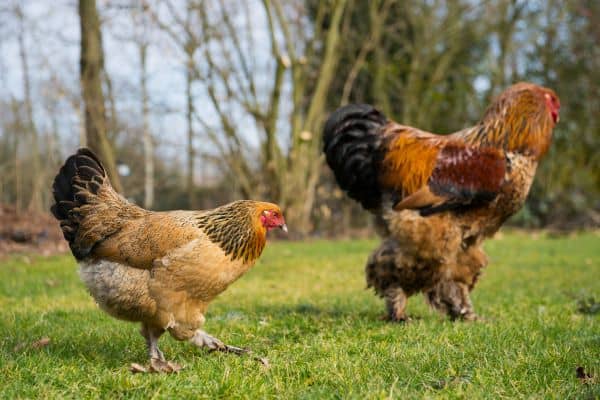
Feathers and Comb Types
Let’s start with their comb types. Brahma chickens sport a distinctive pea comb that sits low on their regal heads. This adds to their overall majestic appearance and gives them an air of sophistication. It’s like they’re saying, “We’re not just any old chickens, we’re Brahma chickens!”
Now, onto their feathers. Brahma chickens are known for their feathered feet.
In terms of appearance, Brahma chickens come in just three main recognized color varieties, including the Light Brahma, Buff Brahma, and dark Brahma.
Temperament
Not only are Brahma chickens absolute show-stoppers in the looks department, but they also have a temperament to match their appearance. These gentle giants are known for their calm and docile nature, making them a favorite among chicken keepers.
Are Brahma chickens friendly?
Are Brahma chickens friendly? Absolutely! These gentle giants are known for their calm temperament and friendly nature, making them a great addition to any backyard flock.
Brahmas are not only docile and easy to handle, but they also get along well with humans and other animals. They are known to be exceptionally gentle, making them suitable for families with children or those looking for feathered companions that are easy to interact with.
Their gentle behavior also makes them a popular choice for backyard pets. Whether you want a chicken that you can pick up or one that will happily roam around the backyard with you, the Brahma chicken will not disappoint. (Keep in mind this takes work to keep them friendly. Chickens are naturally afraid of almost everything)
In addition to their friendly nature, Brahma chickens have many other desirable traits. They are one of the largest breeds of chicken, with a wide body and feathered feet. Their massive size makes them quite the spectacle and they are often referred to as “gentle giants.”
So, if you’re looking for a chicken breed that combines size, beauty, and a friendly temperament, the Brahma chicken is the perfect choice. They will not only provide you with a calm and relaxing backyard experience but also make wonderful companions for both humans and other animals.
Care Requirements
When it comes to caring for Brahma chickens, it’s important to remember that they have some specific needs. Due to their large body size, Brahma chickens require more space per bird compared to your average chicken. They, however, are not high-maintenance creatures.
As long as they have access to clean water, a nutritious diet, and a dust bath area to keep their feathers in tip-top shape, they will thrive.
With their hardy and healthy disposition, Brahma chickens don’t require extensive veterinary care, but it’s always important to keep an eye out for common chicken health issues, such as scaly leg mites because of their feathered legs they can be a bit more susceptible.
Coop Space
When it comes to coop space for Brahma chickens, you gotta think big. These gentle giants are not your average chickens, my friend. With their large size and fancy feathered feet, they need some extra room to strut their stuff.
Unlike your run-of-the-mill chicken breeds, Brahma chickens require more space to roam. So, make sure your coop is spacious enough to accommodate their hight above the roosting poll. Brahma chickens also need a coop with larger nesting boxes and wide perches to accommodate their size. But its also important that the roost only be a few feet off the ground so they don’t damage their legs when jumping down each day. This can also cause issues with bumble foot (basically an abscess in the bottom of their foot.) if they are hitting the ground hard.
To give you a rough idea, the recommended minimum square footage per Brahma chicken is around 8-10 square feet if you are going to keep them contained full-time.
Free Range
Let’s talk about Free Range. — Free Range chickens are able to strut their stuff, peck at bugs, and scratch the ground to their heart’s content. This lifestyle not only keeps them physically active and entertained, but it also allows them to exhibit their natural behaviors.
However, make sure they can not access things like your garden or some area you don’t care that they will take a poop on any time they feel like it. Thats life with chickens.
Here are some ideas to help keep them off the porch and a few other containment tricks.
Don’t Know Where To Start With Your Backyard Farm?
Its time to start a backyard farm that fits YOUR dream lifestyle, Backyard Farm Foundation is the answer to setting a clear plan and achievable goals for starting your dream backyard farm or homestead.
ONLY $9!!!!

Do Brahma hens Go broody?
Oh, let’s talk about broodiness behavior in those fabulous Brahma hens! These birds are known for their size and gentle nature, but they also have a tendency to go broody. Meaning they have a habit of wanting to set on a clutch of eggs even if they may not be fertilized. (They are chickens, they aren’t that smart)
So, how can you recognize a broody Brahma hen? Well, first of all, she’ll be hanging out in the nest box, refusing to budge. You might even notice some changes in her behavior, like puffing up her feathers and making weird clucking noises. She may even get aggressive when you get too close to where she is nested down. Trust me, you’ll know when you see it!
If you don’t want your chickens to go broody make sure you collect the eggs every day. If a hen is sitting on a nest of eggs pick her up and take the eggs. If you think she is just trying to lay an egg of her own you can put her back but if she is trying to set on eggs then put her outside the coop every day she does that until it breaks the habit.
Are Brahma chickens good for meat?
These gentle giants are not only known for their impressive size, but they also pack a punch when it comes to meat production. They do make a good dual-purpose breed. HOWEVER, they do take longer to grow so they are not a good choice if you are getting them solely for meat birds. — Broilers are a better choice for raising your own meat.
They can reach heights of up to 2 feet tall and weigh a hefty 9 to 13 pounds. – Like any poultry you lose about 1/3rd of the light body weight after harvest.
Brahma chickens are a very large breed making them perfect for homesteaders wanting to use every aspect of the chickens they raise once they get too hold to produce eggs.
